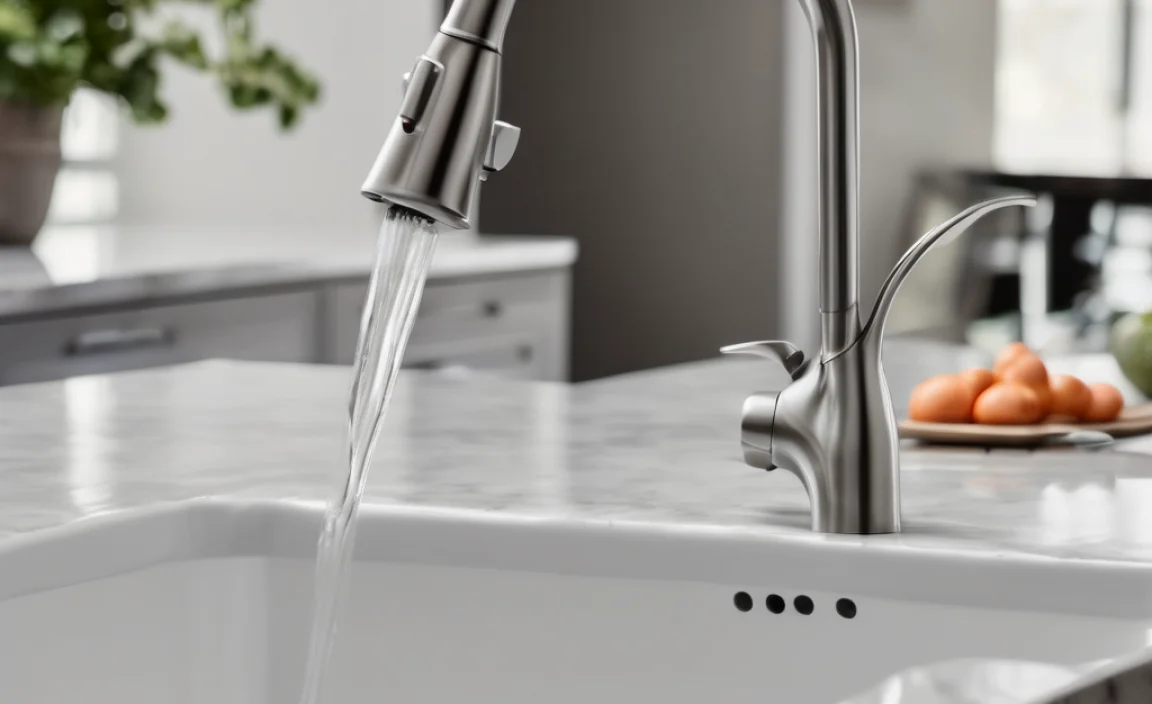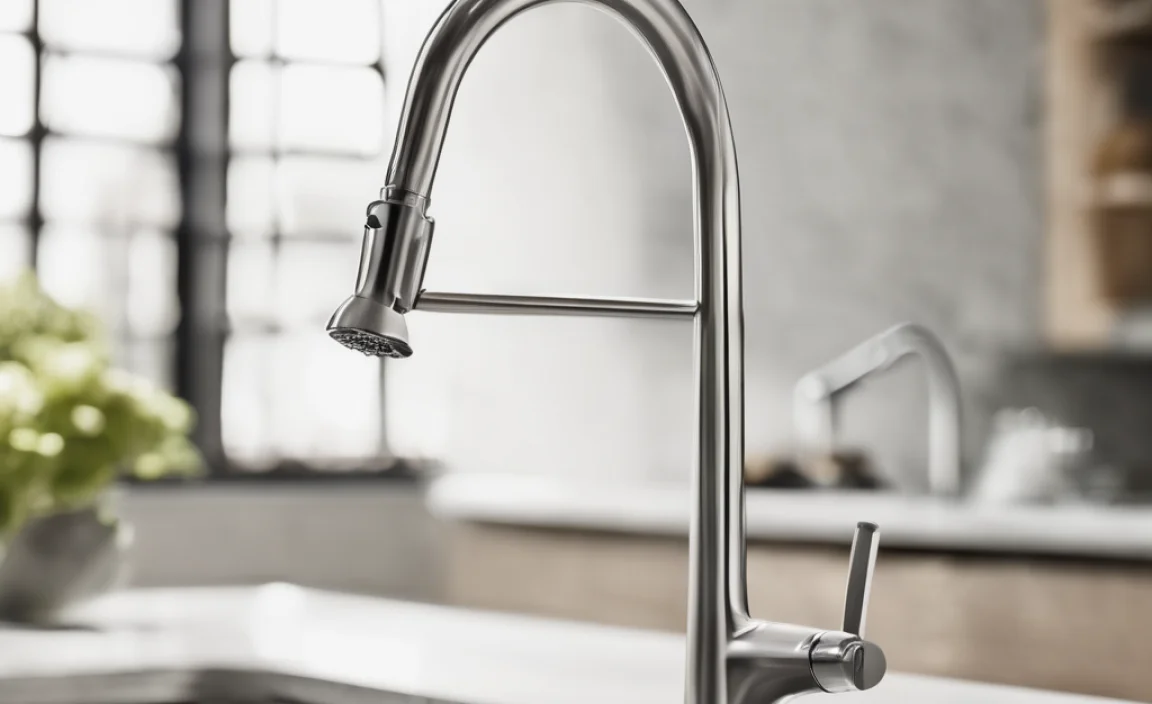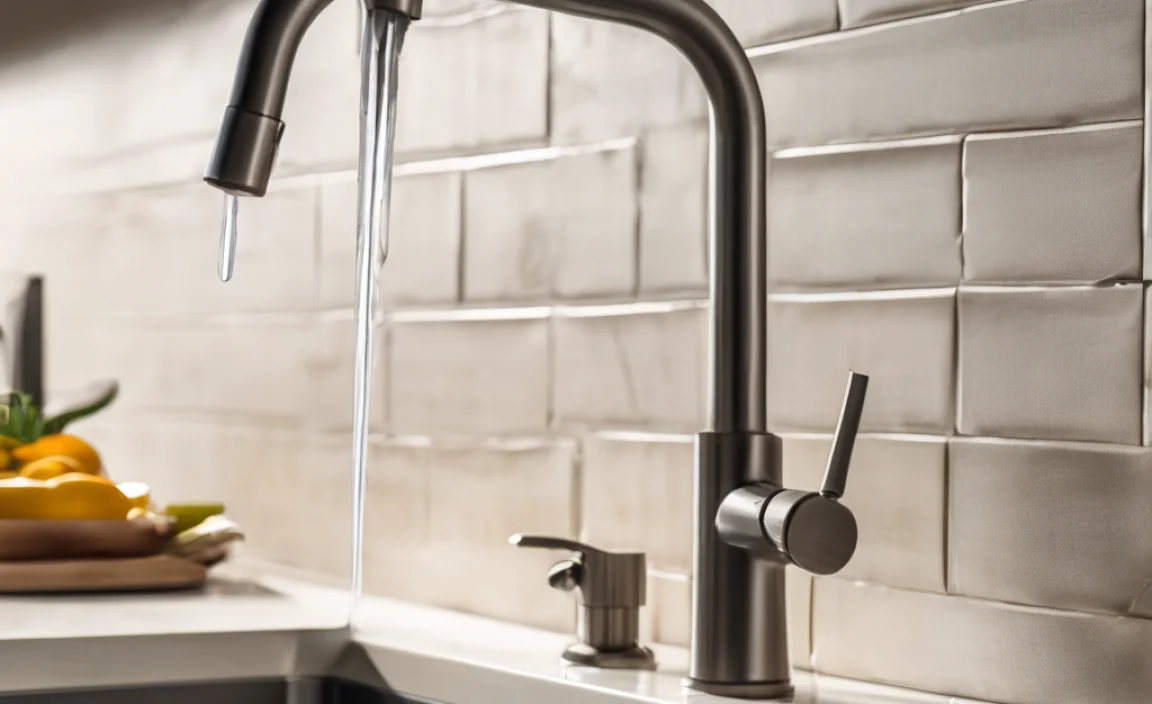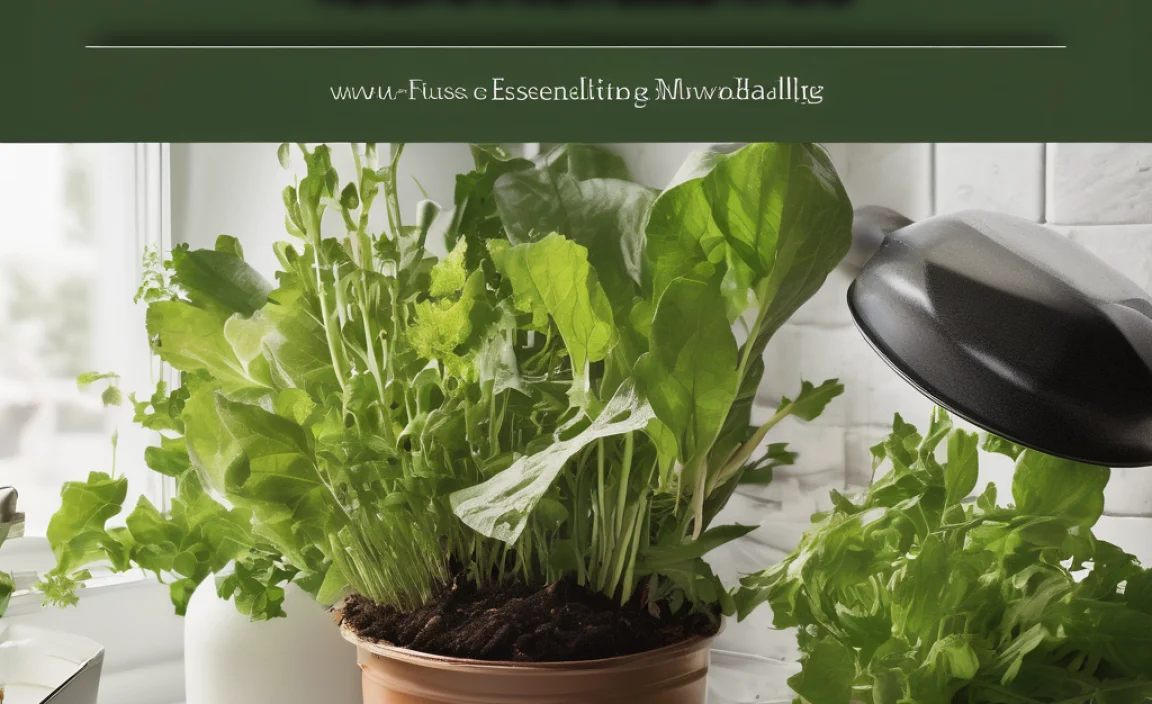Matching your kitchen faucet to your cabinet hardware is a matter of personal style, not a strict rule. While coordinating finishes can create a cohesive look, mixing metals is a popular trend that adds character. Consider the overall style of your kitchen and choose what you love!
Choosing the right finishes for your kitchen can feel overwhelming. Do your cabinet knobs *really* need to match your faucet? It’s a question that plagues many homeowners. The good news is, there’s no right or wrong answer! It all boils down to your personal taste and the overall vibe you want to create in your kitchen.
In this guide, we’ll walk you through the considerations to help you decide whether to match or mix your kitchen faucet and cabinet hardware. We’ll cover design principles, current trends, and practical tips to make your kitchen shine. Let’s dive in and create a kitchen you’ll love!
Matching vs. Mixing: Understanding the Basics

The first step is understanding the impact of matching versus mixing finishes. Each approach offers unique aesthetic benefits.
The Case for Matching
Matching finishes creates a sense of harmony and intentional design. It’s a classic approach that brings a clean, polished look to your kitchen.
- Creates a Cohesive Look: Matching provides visual consistency.
- Simple and Timeless: It’s a safe bet if you prefer a traditional style.
- Easy to Achieve: Less decision fatigue, as you’re sticking to one finish.
The Appeal of Mixing
Mixing finishes allows you to add personality and depth to your kitchen. It’s a more contemporary approach that can highlight specific elements and create visual interest.
- Adds Visual Interest: Mixing introduces layers and prevents a monotonous look.
- Highlights Key Features: You can draw attention to certain elements like your faucet or cabinet hardware.
- Reflects Personal Style: It showcases your unique taste and creativity.
Factors to Consider When Choosing

Several factors can influence your decision on whether to match or mix your kitchen finishes. Let’s explore these in detail.
Kitchen Style
The overall style of your kitchen plays a crucial role in determining the best approach.
- Traditional Kitchens: Matching finishes often work well in traditional kitchens, enhancing their classic elegance. Think polished brass faucets with matching cabinet knobs.
- Modern Kitchens: Mixing metals can add an edgy, contemporary touch to modern kitchens. Consider a matte black faucet with stainless steel cabinet pulls.
- Farmhouse Kitchens: A mix of finishes can enhance the rustic charm of farmhouse kitchens. For example, an oil-rubbed bronze faucet paired with antique brass hardware.
- Eclectic Kitchens: This style is all about showcasing personality, so feel free to experiment with a variety of finishes.
Color Palette
The colors in your kitchen can guide your choice of finishes. Neutral kitchens offer more flexibility, while colorful kitchens may benefit from a more coordinated approach.
- Neutral Colors: If your kitchen features a neutral palette (whites, grays, beiges), you have the freedom to choose either matching or mixed finishes.
- Bold Colors: In kitchens with bold cabinet or backsplash colors, matching finishes can create a more balanced and harmonious look.
- Warm vs. Cool Tones: Consider whether your kitchen leans towards warm or cool tones. Warm finishes like gold and copper pair well with warm-toned cabinets, while cool finishes like stainless steel and chrome complement cool-toned cabinets.
Lighting
Lighting can significantly impact how finishes appear. Natural light enhances the warmth of metallic finishes, while artificial light can alter their appearance.
- Natural Light: If your kitchen gets plenty of natural light, warm finishes like brass and copper will appear brighter and more vibrant.
- Artificial Light: Under artificial light, cool finishes like chrome and stainless steel can appear more subdued.
- Layered Lighting: A combination of ambient, task, and accent lighting can highlight different finishes and add depth to your kitchen.
Budget
Your budget can also influence your decision. Some finishes are more expensive than others, so mixing can be a cost-effective way to achieve a high-end look without breaking the bank.
- High-End Finishes: Finishes like polished brass and copper tend to be more expensive.
- Budget-Friendly Finishes: Stainless steel and matte black are often more affordable options.
- Mixing and Matching: You can save money by using a more expensive finish for your faucet (the focal point) and pairing it with less expensive cabinet hardware.
Popular Finish Combinations

If you’re leaning towards mixing finishes, here are some popular combinations to consider:
- Matte Black and Gold: This pairing offers a striking contrast that’s both modern and elegant.
- Stainless Steel and Brushed Nickel: A subtle and versatile combination that works well in many kitchen styles.
- Oil-Rubbed Bronze and Antique Brass: This combination enhances the rustic charm of farmhouse kitchens.
- Chrome and Glass: A sleek and contemporary pairing that adds a touch of sophistication.
Step-by-Step Guide to Choosing Your Finishes
Ready to make a decision? Follow these steps to choose the perfect finishes for your kitchen.
Step 1: Assess Your Kitchen’s Style and Color Palette
Take a good look at your kitchen. What style is it? What are the dominant colors? This will help you narrow down your options.
Step 2: Consider Your Lighting
How much natural and artificial light does your kitchen get? This will influence how different finishes appear.
Step 3: Set a Budget
Determine how much you’re willing to spend on your faucet and cabinet hardware. This will help you choose finishes that fit your budget.
Step 4: Gather Inspiration
Browse magazines, websites like Houzz and Pinterest, and social media for kitchen design ideas. Save images of kitchens with finishes you love.
Step 5: Create a Mood Board
Compile your inspiration images, along with samples of your cabinet color, countertop material, and backsplash tile. This will help you visualize how different finishes will look in your kitchen.
Step 6: Test Your Combinations
Before making a final decision, test your chosen finishes in your kitchen. Order samples of faucets and cabinet hardware and see how they look in different lighting conditions.
Step 7: Make Your Decision
Once you’re happy with your chosen finishes, it’s time to make your purchase!
Tools and Resources
Here are some useful tools and resources to help you choose the right finishes:
- Online Design Tools: Use online tools to visualize different finish combinations in your kitchen.
- Finish Samples: Order samples of faucets and cabinet hardware to see how they look in your kitchen.
- Design Professionals: Consult with a kitchen designer or interior designer for expert advice. Houzz is a great resource for finding professionals.
- Color Wheel: Use a color wheel to understand how different colors and finishes complement each other.
Maintaining Your Kitchen Finishes
Once you’ve chosen your finishes, it’s important to maintain them properly to keep them looking their best.
Cleaning Tips
- Regular Cleaning: Wipe down your faucet and cabinet hardware regularly with a soft, damp cloth.
- Mild Soap: Use a mild soap and water solution for cleaning. Avoid harsh chemicals or abrasive cleaners.
- Dry Thoroughly: After cleaning, dry your finishes thoroughly to prevent water spots and corrosion.
Protecting Your Finishes
- Avoid Scratches: Be careful not to scratch your finishes with sharp objects.
- Prevent Water Spots: Wipe up spills and water spots immediately to prevent them from becoming permanent.
- Use Protective Coatings: Consider applying a protective coating to your finishes to prevent tarnishing and corrosion.
Troubleshooting Common Issues
Here are some common issues you may encounter with your kitchen finishes and how to resolve them:
| Issue | Solution |
|---|---|
| Water Spots | Wipe down finishes with a soft cloth after each use. Use a water spot remover for stubborn spots. |
| Tarnishing | Use a metal polish specifically designed for your finish. Follow the manufacturer’s instructions carefully. |
| Scratches | Use a scratch repair kit designed for your finish. For deep scratches, consider replacing the hardware. |
| Corrosion | Clean the affected area with a mild soap and water solution. Apply a protective coating to prevent further corrosion. |
Examples of Kitchen Designs
Let’s look at some examples of kitchens with different finish combinations to inspire your own design.
Example 1: Modern Kitchen with Mixed Metals
This modern kitchen features sleek white cabinets, a matte black faucet, and stainless steel cabinet pulls. The contrast between the black and stainless steel adds visual interest and complements the clean lines of the design.
Example 2: Traditional Kitchen with Matching Finishes
This traditional kitchen features warm wood cabinets, a polished brass faucet, and matching brass cabinet knobs. The matching finishes create a sense of elegance and harmony.
Example 3: Farmhouse Kitchen with Rustic Accents
This farmhouse kitchen features painted cabinets, an oil-rubbed bronze faucet, and antique brass hardware. The combination of finishes enhances the rustic charm of the design.
Trends in Kitchen Finishes
Staying up-to-date with the latest trends can help you create a stylish and modern kitchen.
- Matte Black: Matte black is a popular choice for faucets and cabinet hardware, adding a touch of sophistication and drama.
- Brushed Gold: Brushed gold is a warm and inviting finish that’s perfect for adding a touch of luxury to your kitchen.
- Mixed Metals: Mixing metals is a growing trend, allowing you to create a unique and personalized look.
- Touchless Faucets: Touchless faucets are becoming increasingly popular, offering convenience and hygiene benefits.
Expert Tips for Choosing Finishes
Here are some expert tips to help you make the best decision for your kitchen:
- Consider the Undertones: Pay attention to the undertones of your finishes. Warm finishes have yellow or red undertones, while cool finishes have blue or green undertones.
- Balance is Key: If you’re mixing finishes, aim for balance. Use one dominant finish and one or two accent finishes.
- Don’t Be Afraid to Experiment: Don’t be afraid to try new things and experiment with different combinations.
Cost Considerations
Understanding the cost implications of different finishes can help you make a budget-conscious decision.
| Finish | Cost |
|---|---|
| Stainless Steel | Moderate |
| Chrome | Moderate |
| Matte Black | Moderate to High |
| Brushed Nickel | Moderate |
| Polished Brass | High |
| Oil-Rubbed Bronze | Moderate to High |
DIY vs. Professional Installation
Decide whether you want to install your faucet and cabinet hardware yourself or hire a professional.
- DIY Installation: If you’re comfortable with basic plumbing and carpentry, you can save money by installing your faucet and cabinet hardware yourself.
- Professional Installation: If you’re not confident in your DIY skills, it’s best to hire a professional to ensure a proper installation.
Common Mistakes to Avoid
Avoid these common mistakes when choosing your kitchen finishes:
- Ignoring the Kitchen’s Style: Make sure your finishes complement the overall style of your kitchen.
- Choosing Too Many Finishes: Stick to a maximum of three finishes to avoid a cluttered look.
- Forgetting About Maintenance: Choose finishes that are easy to clean and maintain.
Resources for Further Reading
Here are some additional resources to help you learn more about kitchen finishes:
- HGTV: Offers articles and videos on kitchen design and renovation.
- Architectural Digest: Provides inspiration and advice on high-end kitchen design.
FAQ: Does Kitchen Faucet Need to Match Cabinet Hardware?
Let’s tackle some frequently asked questions to give you more clarity.
- Q: Is it mandatory for my kitchen faucet and cabinet hardware to match?
- A: No, it’s not mandatory! It’s a matter of personal preference. You can create a cohesive look by matching or add visual interest by mixing.
- Q: What if I can’t find an exact match?
- A: Don’t worry! Close is often good enough. Or, embrace the opportunity to mix finishes intentionally.
- Q: Is mixing metals a good idea?
- A: Absolutely! Mixing metals is a popular trend. Just make sure the finishes complement each other and the overall kitchen design.
- Q: Which finish is easiest to maintain?
- A: Stainless steel is generally considered the easiest to maintain, as it’s resistant to water spots and fingerprints.
- Q: Can I mix different styles of faucets and cabinet hardware?
- A: Yes, but proceed with caution. Make sure the styles complement each other and the overall kitchen design. For example, a modern faucet can pair well with minimalist cabinet hardware.
- Q: What is the best way to test finish combinations before buying?
- A: Order samples of faucets and cabinet hardware and see how they look in your kitchen’s lighting. You can also create a mood board to visualize the overall look.
- Q: Where can I find inspiration for kitchen finish combinations?
- A: Websites like Pinterest, Houzz, and home decor magazines are great sources of inspiration. Also, visit kitchen showrooms to see different finishes in person.
Conclusion
Choosing whether to match or mix your kitchen faucet and cabinet hardware is a fun part of personalizing your space. There’s no right or wrong answer – it’s all about your personal style and the overall aesthetic you want to achieve. By considering your kitchen’s style, color palette, lighting, and budget, you can confidently choose the perfect finishes to create a kitchen you’ll love for years to come. So go ahead, experiment, and have fun with it!


